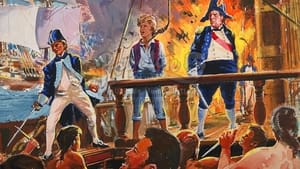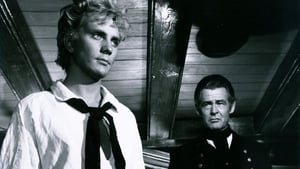Contact: info@alwanfilm.com
Video Sources 0 Views

Synopsis
Review: Billy Budd 1962 Colorized – An In-Depth Exploration of a Cinematic Classic

Introduction
In the annals of classic cinema, few films evoke the same level of enduring intrigue and emotional resonance as “Billy Budd 1962.” Directed by the distinguished filmmaker Peter Ustinov, this adaptation of Herman Melville’s novella delves into themes of justice, innocence, and the human condition. The film’s 1962 release remains a landmark moment in cinematic history, and in this article, we will explore the film’s narrative depth, its impact on viewers, and the significance of its place within the broader context of film and literature.
Check The Full Colorized Movies List
Check Our Colorized Movies Trailer Channel
Understanding Billy Budd 1962 Colorized: Director, Cast, and Genre
“Billy Budd 1962” emerges from the vision of Peter Ustinov, a multifaceted artist known for his work as an actor, director, and playwright. Ustinov’s adaptation of Melville’s novella reflects his keen understanding of both literary and cinematic storytelling. The film features a stellar cast, including Terence Stamp as the eponymous Billy Budd, Robert Ryan as the malevolent Claggart, and Ustinov himself in the role of Captain Vere.
The film is a dramatic adaptation that seamlessly blends elements of historical drama, psychological thriller, and moral allegory. Set against the backdrop of a British naval ship in the late 18th century, “Billy Budd 1962” explores complex themes of law, morality, and the clash between individual virtue and institutional authority.
Exploring the World of Billy Budd 1962 Colorized: Plot and Characters
At the heart of “Billy Budd 1962” lies the tragic story of Billy Budd, a young sailor whose innocence and naivety stand in stark contrast to the harsh realities of life aboard a British man-of-war. Accused of mutiny by the ship’s master-at-arms, Claggart, Billy faces a dire predicament that pits his innate goodness against a rigid and unforgiving legal system.
The film unfolds with a keen focus on character development and dramatic tension. Terence Stamp’s portrayal of Billy Budd captures the character’s innocence and vulnerability, while Robert Ryan’s Claggart is a chilling embodiment of cruelty and malice. Ustinov’s Captain Vere serves as a conflicted arbiter of justice, grappling with his own moral dilemmas and the weight of responsibility.
The Art of Cinematic Adaptation
The adaptation of literary works to the screen is a delicate art, requiring a nuanced understanding of both the source material and the cinematic medium. In “Billy Budd 1962,” Peter Ustinov navigates this challenge with skill, capturing the essence of Melville’s novella while infusing the story with cinematic flair.
Ustinov’s adaptation remains faithful to the spirit of Melville’s narrative, retaining the novella’s thematic depth and moral ambiguity. However, it also leverages the visual and dramatic potential of film to enhance the storytelling experience, using cinematography, performance, and music to convey the emotional and psychological landscape of the story.
The Legacy of Billy Budd 1962 Colorized
“Billy Budd 1962” stands as a testament to the enduring power of Melville’s novella and Ustinov’s directorial vision. The film’s exploration of themes such as justice, innocence, and the nature of authority continues to resonate with audiences and critics alike, affirming its status as a classic of cinema.
The film’s legacy is marked by its critical acclaim, including notable awards and nominations. Terence Stamp’s performance garnered widespread praise, solidifying his reputation as one of the era’s most talented actors. Ustinov’s direction also received acclaim for its thoughtful and nuanced approach to the source material.
Director’s Cinematic Legacy: Beyond Billy Budd 1962 Colorized
Peter Ustinov’s cinematic legacy extends far beyond “Billy Budd 1962,” encompassing a diverse body of work that spans acting, directing, and writing. Ustinov’s contributions to film and theater reflect his versatility and creativity, earning him recognition as a multifaceted artist.
In addition to “Billy Budd 1962,” Ustinov’s filmography includes notable works such as “Spartacus,” “Lalita,” and “Death on the Nile.” His impact on cinema is marked by his ability to tackle a wide range of genres and subjects, bringing depth and nuance to his performances and directorial projects.
Themes Explored in Billy Budd 1962 Colorized
“Billy Budd 1962” delves into complex themes that challenge viewers to reflect on the nature of justice, morality, and the human condition. The film’s exploration of innocence versus corruption, individual versus institution, and moral ambiguity provides a rich tapestry for analysis and interpretation.
The character of Billy Budd embodies the ideal of innocence and virtue, standing in stark contrast to the corrupt and malevolent Claggart. The tension between these opposing forces serves as a powerful commentary on the complexities of human nature and the often arbitrary nature of justice.
Reception and Controversy Surrounding Billy Budd 1962 Colorized
The release of “Billy Budd 1962” was met with critical acclaim, though not without some controversy. Critics praised the film for its strong performances, particularly Terence Stamp’s portrayal of Billy Budd, and Ustinov’s adept handling of the source material. However, some viewers debated the film’s interpretation of Melville’s novella, with differing opinions on the adaptation’s fidelity and impact.
Despite these debates, the film’s reputation as a classic of cinema endures, with ongoing discussions about its thematic depth and artistic merit. The film’s ability to provoke thought and engage audiences remains a testament to its enduring significance.
Where to Watch Billy Budd 1962 Colorized Online
For those interested in experiencing the cinematic brilliance of “Billy Budd 1962,” the film is available on various streaming platforms and digital rental services. Whether revisiting the film or experiencing it for the first time, viewers can explore the timeless themes and powerful performances that define this classic work.
FAQs About Billy Budd 1962 Colorized
Common questions about “Billy Budd 1962” often revolve around its adaptation, thematic elements, and historical context. Addressing these queries can provide valuable insights into the film’s significance and interpretation.
Q: How does “Billy Budd 1962” compare to Herman Melville’s novella?
A: Peter Ustinov’s adaptation of Melville’s novella remains faithful to the core themes and narrative of the original work while leveraging the cinematic medium to enhance the storytelling experience. The film captures the essence of Melville’s story while adding visual and dramatic elements unique to cinema.
Q: What are the major themes explored in the film?
A: “Billy Budd 1962” explores themes of innocence versus corruption, individual versus institution, and the nature of justice. The film delves into the moral and psychological complexities of its characters, offering a thought-provoking examination of human nature and authority.
Q: What makes Terence Stamp’s performance notable in the film?
A: Terence Stamp’s portrayal of Billy Budd is widely praised for its depth and authenticity. Stamp’s performance captures the character’s innocence, vulnerability, and moral integrity, making him a standout in the film and contributing to its critical acclaim.
Conclusion
In conclusion, “Billy Budd 1962” stands as a significant achievement in cinematic adaptation, reflecting Peter Ustinov’s directorial vision and the enduring power of Herman Melville’s novella. The film’s exploration of complex themes and its portrayal of iconic characters continue to resonate with audiences and critics alike.
As viewers engage with “Billy Budd 1962,” they are invited to reflect on the nature of justice, innocence, and authority, and to consider the broader implications of these themes within the context of human experience. The film’s legacy endures as a testament to the power of storytelling and the enduring relevance of its central themes.












